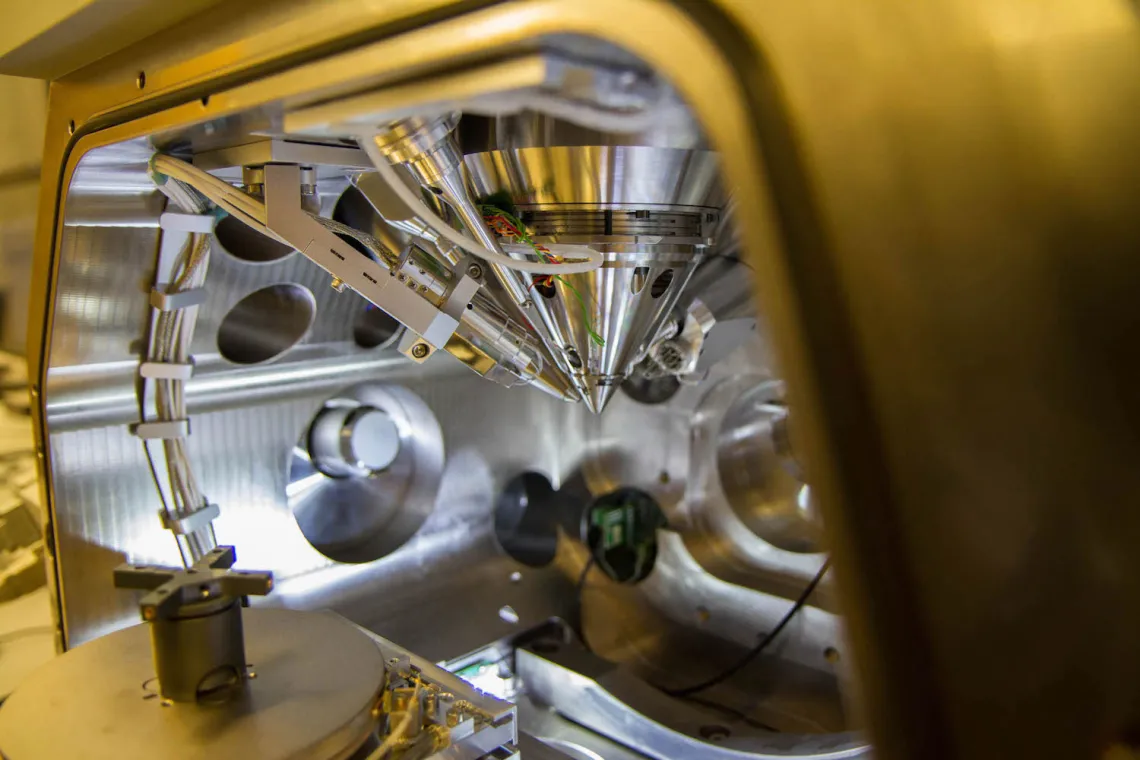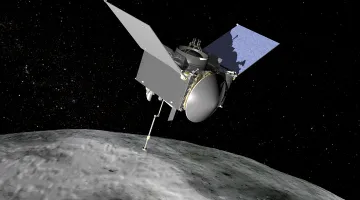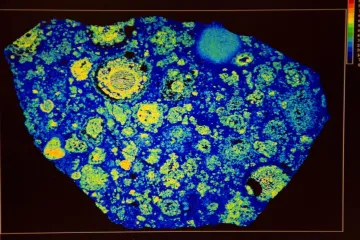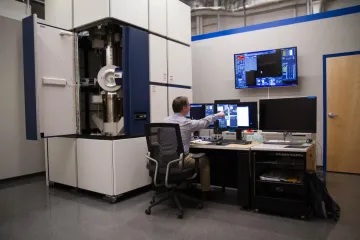So You Want to Analyze Asteroid Dirt
In the basement of a building constructed with NASA funds in the early 1960s, University of Arizona scientists prepare to study asteroid dirt from OSIRIS-REx, a first-of-its-kind NASA mission.

In the year 2023, priceless property of the American people will land somewhere in the Utah desert. And when it does, a team of engineers and scientists will be waiting on the ground. Thousands will watch with eyes glued to smart phones and televisions. Headlines around the world will tell of its journey.
The priceless property is 2 to 70 ounces of asteroid dirt.
This 4.5-billion-year-old dirt, formally known as “regolith,” will look like a small pile of dusty rubble, gleaned in the five-second moment during which NASA’s OSIRIS-REx spacecraft vacuumed the surface of a carbon-rich, near-Earth asteroid called Bennu.

Graphic illustration of OSIRIS-REx spacecraft touching Bennu
Landing, encapsulated, at the Utah Test and Training Range on the planet Earth will begin a new phase in its existence in the universe: analysis. After being transported to the Johnson Space Center in Houston, the dirt will be removed from its capsule, and then allocated to scientists for study.
OSIRIS-REx is the United States’ first mission to return an asteroid sample to Earth, but for scientists like Tom Zega, return to Earth is just the beginning. Zega is a sample scientist at the University of Arizona. As a collaborator on the OSIRIS-REx mission, led by NASA and the UA, he will be one of the first scientists to analyze regolith from Bennu.
Why Return Samples?
One of the main goals of the OSIRIS-REx mission, he says, is understanding the earliest history of our solar system, and the origins of life. Regolith from an asteroid might be our best shot at this.
“Sample return is great because otherwise you’re at the mercy of what falls from the sky,” says Zega. Simply, you get what you get. The regolith from Bennu will be untouched. Uncontaminated by our atmosphere. Pristine. “Sample return is a treasure trove of information.”
“You’re getting samples that are older than Earth. I can literally hold in my hand a piece of the origins of our solar system that predated Earth, predated human beings, predated everything we know,” says Zega. “These are atoms that assembled four and a half billion years ago and became the building blocks of our planet.”
The only question left is what to do with such a scientifically valuable pile of dirt.
Building a Lab Fit for Analysis

“Analysis” can mean many things. In the case of using asteroid regolith to understand the origins of the solar system, analysis means two things, both of which require large equipment in a stable environment. The first: high-resolution imaging. The second: measuring chemistry. Respectively, answering the questions “What does it look like?” and “What is it made of?”
“We’re sort of like forensic scientists,” says Zega. “Nature grew these materials, and we’re analyzing it at a fundamental level to figure out under what conditions.”
Zega does this in the 5,000-square-foot basement of the Kuiper Space Sciences building, constructed at the UA in 1964 with funds from NASA. The basement was once a mirror lab for telescopes and a publications vault. Telescopes got bigger, and so did the mirror lab. It now lives under UA’s Arizona Stadium. Publications went online. Now, the UA’s collection of high-tech electron microscopes—to be used for studying the returned asteroid dirt—live here.
Sensitive to stimulus, electron microscopes need a place with minimal vibrations, minimal electromagnetic interference, and good acoustics. As it turns out, explains Zega as he stands outside the two frosted doors of the lab, basements make good spots for these kinds of microscopes. As of today, the lab is “ready to hit the ground running” when the asteroid sample from OSIRIS-REx shows up.
In fact, the lab is in the process of studying a sample from Hayabusa 1, an asteroid sample return mission by JAXA, the Japanese equivalent of NASA. Like OSIRIS-REx, Hayabusa 2 is now cruising towards its target, the asteroid Ryugu.
He opens the doors, revealing a long, clean, fluorescent-lit corridor.
Analyzing the Sample
At the end of the corridor, in a room on the left, is where the asteroid sample’s time in the lab will truly begin. After it’s mounted on a glass slide and polished smooth, Zega will place the sample in an electron microprobe.
“The microprobe gives us the most context, and a lay of the land,” says Zega. It allows him to photograph the entire sample in high-resolution, and map out its chemistry, element by element. Those elements, like iron and nickel and magnesium, show up as colors on a computer screen.

Chemical map of a meteor sample
“You want to sit down and really process that data. You might want to play around with the maps and overlay them onto the high-res images that you also created before you decide what the next step is. That can take some time,” says Zega. “You really want to take your time here before going onto a more detailed level of analysis.”
Then, all the way at the other end of the corridor, near the doorway, there are two scanning electron microscopes. Like the microprobe, they too image and chemically map the sample, but at an even more detailed level. Here, Zega can look at the dirt in micrometers and nanometers—a billionth of a meter. A single sheet of paper is about 100,000 nanometers thick.
In the room next door, a focused-ion-beam scanning-electron microscope can look at the sample in even greater detail. It can also drill a hole in a piece of dust from the asteroid by shooting gallium ions at it, like teeny-tiny bullets.
“Every atom has something to tell us,” says Zega, walking toward the final destination for the asteroid sample: the transmission electron microscope, or TEM. It’s a towering box of off-white and blue, about 12-feet-tall. There’s an innate humor in its largeness, because a TEM is the only machine in the world that can see something as tiny as an individual atom. The TEM, purchased from Hitachi High Technologies in 2016, was shipped by boat from Japan months earlier. A team of engineers from the company’s headquarters outside of Tokyo has been here since November, installing and calibrating the microscope. They are expected to head home in June.

Hitachi transmission electron microscope
“Looking at microstructures is useful for figuring out origins,” explains Zega. Which atoms of an element are next to, or layered on top of, which other atoms is critically important when you want to figure out how something formed.
Looking to the Stars for Answers
In the best case scenario, analyzing the asteroid dirt means “we rewrite the textbooks on our understanding of the origins of our solar system,” says Zega. “I think that’s the neatest thing about a mission like this. It can be full of surprises.”
“Scientist or not, we all look to the stars and ask ‘How?’ and ‘Why?’ We wonder how it all came to be,” says Zega. “The work that we do here at the University of Arizona contributes to answering those questions.”

